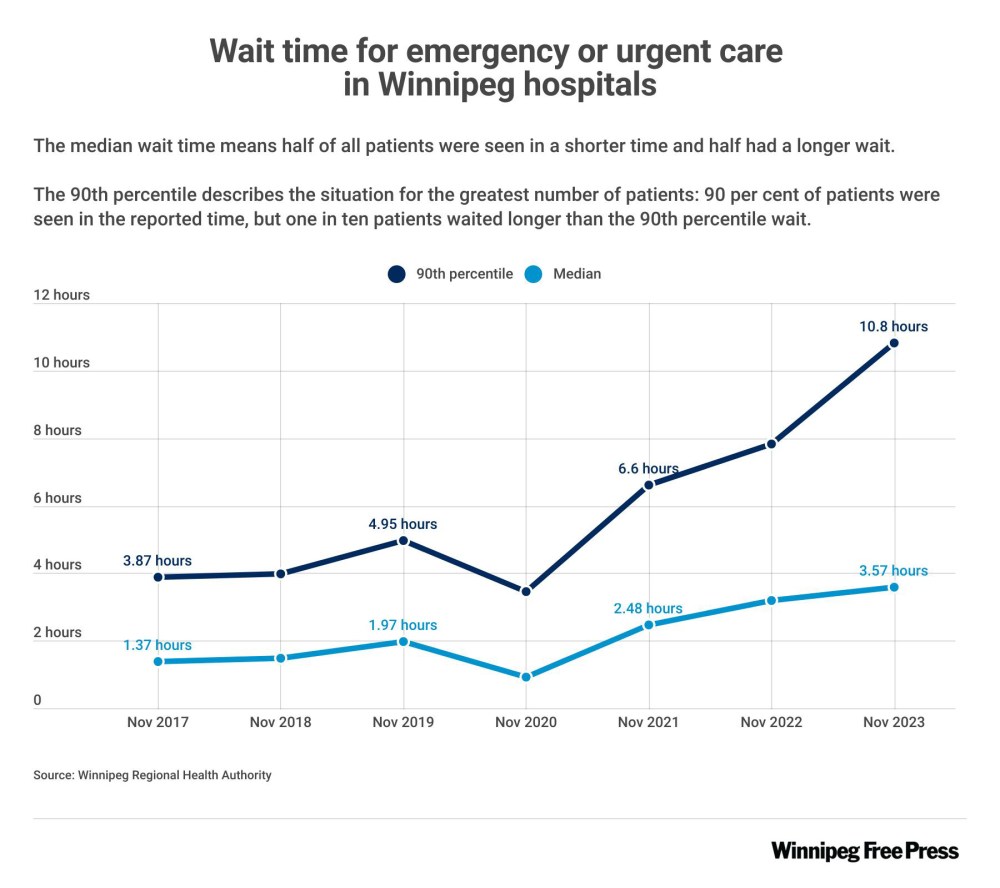Ruinous Tory ‘reforms’ left ERs on life-support in gravely ill hospitals
Advertisement
Read this article for free:
or
Already have an account? Log in here »
To continue reading, please subscribe:
Monthly Digital Subscription
$0 for the first 4 weeks*
- Enjoy unlimited reading on winnipegfreepress.com
- Read the E-Edition, our digital replica newspaper
- Access News Break, our award-winning app
- Play interactive puzzles
*No charge for 4 weeks then price increases to the regular rate of $19.00 plus GST every four weeks. Offer available to new and qualified returning subscribers only. Cancel any time.
Monthly Digital Subscription
$4.75/week*
- Enjoy unlimited reading on winnipegfreepress.com
- Read the E-Edition, our digital replica newspaper
- Access News Break, our award-winning app
- Play interactive puzzles
*Billed as $19 plus GST every four weeks. Cancel any time.
To continue reading, please subscribe:
Add Free Press access to your Brandon Sun subscription for only an additional
$1 for the first 4 weeks*
*Your next subscription payment will increase by $1.00 and you will be charged $16.99 plus GST for four weeks. After four weeks, your payment will increase to $23.99 plus GST every four weeks.
Read unlimited articles for free today:
or
Already have an account? Log in here »
Hey there, time traveller!
This article was published 05/01/2024 (704 days ago), so information in it may no longer be current.
The latest emergency-room wait-time numbers for Winnipeg hospitals are catastrophic. There’s no other way to put it.
ER wait times, no matter how you measure them, have never been this high, at least not since the Winnipeg Regional Health Authority began publishing them 10 years ago.
The longest wait time for nine out of 10 ER patients (the 90th percentile) at Grace Hospital skyrocketed to 14.35 hours in November, according to the most recent data released by the WRHA.
It’s the highest it’s ever been. Until the fall of 2023, ER wait times at Grace had never been close to double-digit levels.
The same goes for St. Boniface Hospital, where wait times hit the 10-hour mark (90th percentile) for the first time ever in the fall of 2022. The number soared to 14.37 hours just weeks ago, in November. The longest wait time for nine out of 10 ER patients at Health Sciences Centre was a record 13.77 hours in November. It’s staggering, it’s dangerous and it’s a massive health-care failure left behind by the former Progressive Conservative government.
Overall, the 90th-percentile wait time among all Winnipeg hospitals (including urgent-care centres) was 10.8 hours in November, up from 10.38 hours in October. It’s never been that high. It was 7.83 in November 2022.
The wait times are now close to three times what they were six years ago when the Tories began consolidating hospital operations in November 2017. The 90th percentile wait time that month was only 3.87 hours.
The magnitude is the same for median wait times — the point at which half of patients wait longer and half wait less. Median ER wait times for all hospitals in Winnipeg jumped to 3.57 hours in November, the highest it’s been since at least 2014. It’s almost three times as high as it was in November 2017, when it was 1.37 hours.
This isn’t a short-term spike caused by the most recent wave of respiratory illnesses. Nor is it caused by people showing up at ERs who don’t need to be there (multiple studies have debunked that often-cited theory).
This is being driven by years of disastrous health-care policy that has caused severe overcrowding, not just in ERs but throughout entire hospitals. It’s most visible in ERs because that’s where the bottlenecks occur.
When patients are sick enough to be admitted to hospital and there are no staffed hospital beds available for them, they pile up in ERs — often for days — forcing incoming patients to wait longer to see a doctor. Data shows an increasing number of patients are now leaving ERs without being seen by a physician, which can cause further medical complications.
There’s no question the former Tory government’s hospital reform plan (and the acute-care funding cuts that went along with it) are the main causes of today’s overcrowding. The changes resulted in fewer staffed hospital beds throughout the system and drove scores of front-line workers — including nurses — into early retirement or the private sector.
Hospitals don’t have the capacity to handle current levels of patient demand. Unfortunately, there are no silver-bullet solutions to fix a problem that was years in the making.
Reopening three emergency departments in the city, as the NDP government has pledged to do, is not the answer. That was an election campaign gimmick that is not supported by evidence-based analysis.
Weak links must be strengthened
Reopening ERs would require transforming Victoria, Seven Oaks and Concordia hospitals back into tertiary-care facilities with intensive-care units and other services that ERs require. It would spread limited resources too thin. The system can’t properly staff the three tertiary-care centres it has now (Grace, St. Boniface and HSC). Trying to staff six acute-care hospitals would be a nightmare.
Reducing overcrowding is more complicated than simply staffing more hospital beds or reopening ERs. The problem is caused by a combination of staff shortages and poor patient flow in hospitals, including delays in discharging patients.
Those delays are driven by multiple factors, including a shortage of long-term care beds, unavailability of home care, a lack of occupational therapists and other allied health-care workers. Together they contribute to “access block” in hospitals, which backs up into ERs and drives up wait times. All those weak links must be strengthened to help increase capacity.
The frightening part is hospital overcrowding and long ER wait times will probably get worse before they get better.
tom.brodbeck@freepress.mb.ca

Tom Brodbeck is an award-winning author and columnist with over 30 years experience in print media. He joined the Free Press in 2019. Born and raised in Montreal, Tom graduated from the University of Manitoba in 1993 with a Bachelor of Arts degree in economics and commerce. Read more about Tom.
Tom provides commentary and analysis on political and related issues at the municipal, provincial and federal level. His columns are built on research and coverage of local events. The Free Press’s editing team reviews Tom’s columns before they are posted online or published in print – part of the Free Press’s tradition, since 1872, of producing reliable independent journalism. Read more about Free Press’s history and mandate, and learn how our newsroom operates.
Our newsroom depends on a growing audience of readers to power our journalism. If you are not a paid reader, please consider becoming a subscriber.
Our newsroom depends on its audience of readers to power our journalism. Thank you for your support.








